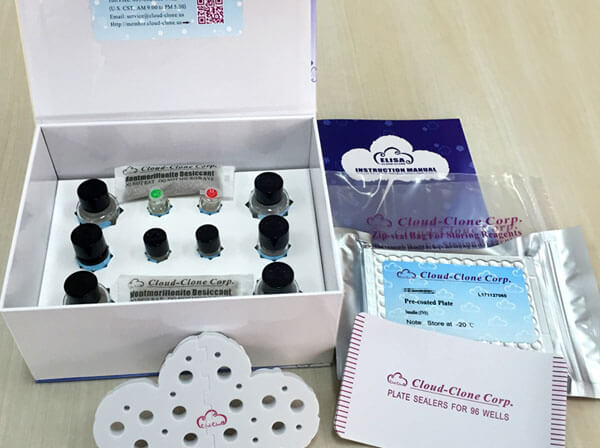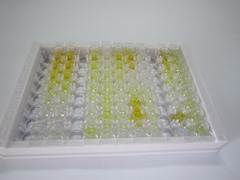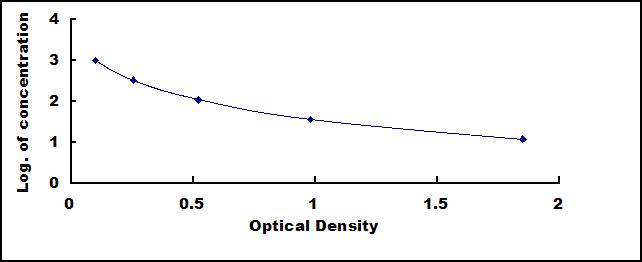ELISA Kit for Corticotropin Releasing Factor (CRF) 

CRH; Corticotropin Releasing Hormone; Corticoliberin
- UOM
- FOB US$ 441.00 US$ 630.00 US$ 2,835.00 US$ 5,355.00 US$ 44,100.00
- Quantity
Overview
Properties
- Product No.CEA835Hu
- Organism SpeciesHomo sapiens (Human) Same name, Different species.
- ApplicationsEnzyme-linked immunosorbent assay for Antigen Detection.
Research use only - DownloadInstruction Manual
- CategoryEndocrinologyCardiovascular biologyNeuro scienceHormone metabolism
Sign into your account
Share a new citation as an author
Upload your experimental result
Review

Contact us
Please fill in the blank.
Recovery
Matrices listed below were spiked with certain level of recombinant Corticotropin Releasing Factor (CRF) and the recovery rates were calculated by comparing the measured value to the expected amount of Corticotropin Releasing Factor (CRF) in samples.
| Matrix | Recovery range (%) | Average(%) |
| serum(n=5) | 85-93 | 89 |
| EDTA plasma(n=5) | 91-101 | 95 |
| heparin plasma(n=5) | 93-101 | 97 |
Precision
Intra-assay Precision (Precision within an assay): 3 samples with low, middle and high level Corticotropin Releasing Factor (CRF) were tested 20 times on one plate, respectively.
Inter-assay Precision (Precision between assays): 3 samples with low, middle and high level Corticotropin Releasing Factor (CRF) were tested on 3 different plates, 8 replicates in each plate.
CV(%) = SD/meanX100
Intra-Assay: CV<10%
Inter-Assay: CV<12%
Linearity
The linearity of the kit was assayed by testing samples spiked with appropriate concentration of Corticotropin Releasing Factor (CRF) and their serial dilutions. The results were demonstrated by the percentage of calculated concentration to the expected.
| Sample | 1:2 | 1:4 | 1:8 | 1:16 |
| serum(n=5) | 86-101% | 78-102% | 83-99% | 97-104% |
| EDTA plasma(n=5) | 83-101% | 80-105% | 90-98% | 80-93% |
| heparin plasma(n=5) | 78-92% | 94-101% | 85-99% | 97-105% |
Stability
The stability of kit is determined by the loss rate of activity. The loss rate of this kit is less than 5% within the expiration date under appropriate storage condition.
To minimize extra influence on the performance, operation procedures and lab conditions, especially room temperature, air humidity, incubator temperature should be strictly controlled. It is also strongly suggested that the whole assay is performed by the same operator from the beginning to the end.
Reagents and materials provided
| Reagents | Quantity | Reagents | Quantity |
| Pre-coated, ready to use 96-well strip plate | 1 | Plate sealer for 96 wells | 4 |
| Standard | 2 | Standard Diluent | 1×20mL |
| Detection Reagent A | 1×120µL | Assay Diluent A | 1×12mL |
| Detection Reagent B | 1×120µL | Assay Diluent B | 1×12mL |
| TMB Substrate | 1×9mL | Stop Solution | 1×6mL |
| Wash Buffer (30 × concentrate) | 1×20mL | Instruction manual | 1 |
Assay procedure summary
1. Prepare all reagents, samples and standards;
2. Add 50µL standard or sample to each well.
And then add 50µL prepared Detection Reagent A immediately.
Shake and mix. Incubate 1 hour at 37°C;
3. Aspirate and wash 3 times;
4. Add 100µL prepared Detection Reagent B. Incubate 30 minutes at 37°C;
5. Aspirate and wash 5 times;
6. Add 90µL Substrate Solution. Incubate 10-20 minutes at 37°C;
7. Add 50µL Stop Solution. Read at 450 nm immediately.

Test principle
This assay employs the competitive inhibition enzyme immunoassay technique. A monoclonal antibody specific to Corticotropin Releasing Factor (CRF) has been pre-coated onto a microplate. A competitive inhibition reaction is launched between biotin labeled Corticotropin Releasing Factor (CRF) and unlabeled Corticotropin Releasing Factor (CRF) (Standards or samples) with the pre-coated antibody specific to Corticotropin Releasing Factor (CRF). After incubation the unbound conjugate is washed off. Next, avidin conjugated to Horseradish Peroxidase (HRP) is added to each microplate well and incubated. The amount of bound HRP conjugate is reverse proportional to the concentration of Corticotropin Releasing Factor (CRF) in the sample. After addition of the substrate solution, the intensity of color developed is reverse proportional to the concentration of Corticotropin Releasing Factor (CRF) in the sample.
Giveaways
Increment services
Citations
- Regulation of corticosterone secretion is modified by PFOS exposure at different levels of the hypothalamic–pituitary–adrenal axis in adult male ratsPubmed:24440345
- Immune dysfunction in bipolar disorder and suicide risk: is there an association between peripheral corticotropin‐releasing hormone and interleukin‐1β?Pubmed:24862833
- Differential stress response in rats subjected to chronic mild stress is accompanied by changes in CRH-family gene expression at the pituitary levelPubmed:25236411
- Acute Stress-Induced Changes in Follicular Dermal Papilla Cells and Mobilization of Mast Cells:Implications for Hair Growth.pubmed:27746640
- Heat stress-induced neuroinflammation and aberration in monoamine levels in hypothalamus are associated with temperature dysregulationpubmed:28663093
- Colonic Transit Time and Gut Peptides in Adult Patients with Slow and Normal Colonic Transit Constipationpubmed:29082242
- Effects of n-3 PUFA enriched and n-3 PUFA deficient diets in naïve and Aβ-treated female ratsPubmed:30028991
- Vaccinium bracteatum Leaf Extract Reverses Chronic Restraint Stress-Induced Depression-Like Behavior in Mice: Regulation of Hypothalamic-Pituitary …Pubmed:30038568
- Perfluorooctane sulfonate (PFOS) can alter the hypothalamic-pituitary-adrenal (HPA) axis activity by modifying CRF1 and glucocorticoid receptorsPubmed:29807116
- The depressive-like behaviors of chronic unpredictable mild stress-treated mice, ameliorated by Tibetan medicine Zuotai: involvement in the hypothalamic …Pubmed:29379286
- Hypothalamus-pituitary-adrenal axis involves in anti-viral ability through regulation of immune response in piglets infected by highly pathogenic porcine …Pubmed:29540178
- Bioscience Research
- Contribution of DNA methylation in chronic stress–induced cardiac remodeling and arrhythmias in micePubmed: 31431066
- Altered glucocorticoid metabolism represents a feature of macroph‐agingPubmed: 32463582
- Impairment of CRH in the intestinal mucosal epithelial barrier of pregnant Bama miniature pig induced by restraint stress33408312
- O-GlcNAc/Akt pathway regulates glucose metabolism and reduces apoptosis in liver of piglets with acute cold stress33651993

















